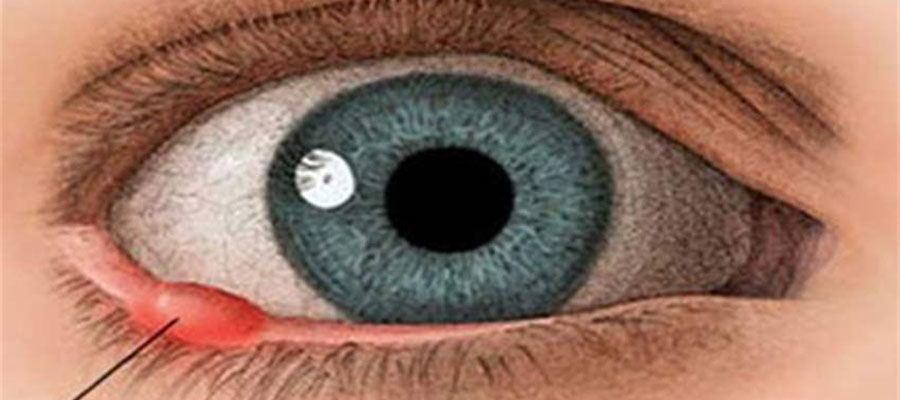What is a stye (hordeolum)?
Stye and Chalazion; A stye (medical name: hordeolum) is a red, painful swelling that develops at the base of the eyelash or on the eyelid. It usually develops as a result of bacterial infection. It is more common in people with eyelid inflammation (blepharitis). There are two types.
- External stye: This is the most common type. It is a bacterial infection that occurs in the eyelash follicles. It looks like acne. There is pain, sensitivity and swelling.
- Internal stye: It is more rare. It is inside the eyelid. It usually occurs as a result of bacterial infection of the sebaceous glands.

What is chalazion?

If the sebaceous glands in the eyelids are blocked, the oil secretion accumulates in the gland and the gland swells. As a result, an inflammatory reaction occurs in the area.
Sometimes chalazion can develop after a stye. It may not be noticed because it does not cause pain in the early period. However, it grows over time and redness occurs along with swelling.
Touching may cause pain. If it is left untreated and gets too large, it can put pressure on the eye and cause astigmatism and eventually blurred vision.
How to distinguish a stye from a chalazion?
It is not always easy to distinguish a stye from a chalazion. The stye is usually on the lid margin, while the chalazion is more behind the lid margin. As a stye develops due to infection, it is painful, red and swollen. Sometimes the entire eyelid may be swollen. An inflamed spot appears on its tip. Chalazion, on the other hand, occurs when the sebaceous gland is blocked and is not very painful since there is no infection.
What are the symptoms of stye and chalazion?
- Symptoms of stye:
- Painful and red swelling in the area near the eyelash root
- Yellow inflamed spot in the middle of the swelling
- Itching
- Watering
- Edema of the eyelid
- Symptoms of chalazion:
- Hard swelling inside the lid that does not cause much pain
- Blurred vision if the chalazion is large
In whom are stye and chalazion seen?
These diseases can happen to anyone. But it is more common in the following cases:
- Eyelid inflammation
- Skin diseases such as acne, rosacea or seborrheic dermatitis
- Oily skin and dandruff hair structure
- Having a stye and chalazion before
. Apart from these, conditions such as scratching the eyes too often, wearing lenses without washing hands, and sleeping without removing eye make-up increase the risk of developing these diseases.
How are stye and chalazion treated?
Especially since the appearance of the stye resembles a pimple, it is sometimes tried to be squeezed by the patients. This should definitely not be done, otherwise the infection may spread to the eyelid and cause more serious problems.
- Often no treatment is required; because the tip of most styes will burst and discharge on their own within 3-4 days.
- Warm compress will reduce the pain and help the inflammation to collect at the tip of the stye and burst and flow out.
- Make-up and contact lens use should be suspended;
- eyelash epilation; If the patient has an external stye, the affected eyelash is pulled. Thus, the focus of infection is eliminated and the inflammation is drained.
- The stye is discharged; it should be done by an ophthalmologist. A small incision is made at the tip of the stye and the stye is pressed to allow the inflammation to flow. You should definitely not do it yourself, otherwise you may cause the infection to spread to the eyelid.
- Drops containing antibiotics and cortisone; help control infection and reduce inflammation. It is used as recommended by your doctor.
- Antibiotic pills are not necessary most of the time. If the infection has spread to the skin, it may rarely be needed to control it.
Chalazion:
- Often no treatment is required; It resolves spontaneously in half of the patients. This can take 2-6 months. If it does not cause any discomfort to the patient, it can be left untreated.
- Warm compress reduces complaints such as pain, redness, swelling. It makes the solidified fluid in the cyst fluid and may facilitate its evacuation.
- Massage: Massaging the cyst after the warm compress facilitates the discharge of the cyst.
- Antibiotic drops: Since there is no infection in the chalazion, it is not necessary to use antibiotic drops.
- Surgery: If the chalazion does not improve despite all treatments, or if it puts pressure on the eye and causes visual impairment, it should be surgically removed. With a small incision on the inside of the eyelid, the cyst is drained and cleaned.






